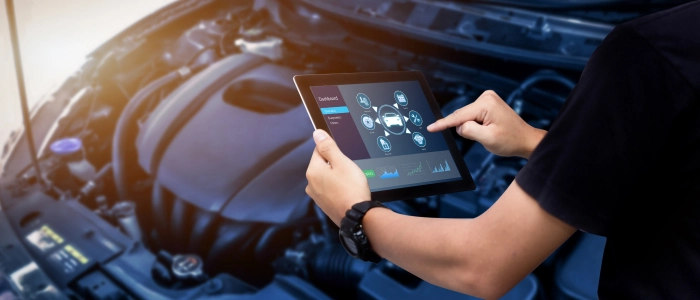The automotive industry in 2025 is no longer just about performance and design. It’s about intelligence. Smart mobility. Real-time data. And the software stitches it all together. As vehicles continue to evolve from mechanical machines to digital platforms, the shift is driven not by hardware—but by the capabilities of automotive software.
For OEMs, Tier-1 suppliers, startups, and even fleet operators, staying ahead means knowing what’s next. Here are the top automotive software trends shaping 2025—and why they matter more than ever.
1. Software-Defined Vehicles (SDV Are No Longer Optional)
Gone are the days when features were locked in at the factory. Software-defined vehicles (SDVs) allow automakers to push new updates, enable features post-sale, and fix bugs remotely. The vehicle becomes a platform that evolves over time, just like your smartphone.
To build these dynamic systems, companies are turning to highly specialized automotive software development services that can support modular design, over-the-air updates, and scalable digital architecture.
2. Cybersecurity by Design
As cars become more connected, they also become more vulnerable. In 2025, cybersecurity is no longer a final checklist item—it’s a foundational layer of vehicle software. Encryption, secure boot, intrusion detection, and compliance with global standards like UNECE WP.29 are baked into every system.
That’s why businesses need a trusted automotive software development company that understands how to build secure systems from day one—not retrofit them later.
3. Real-Time Data Is the New Gold
Modern vehicles generate gigabytes of data daily—from driving behavior and system performance to location and environment context. This data, when analyzed correctly, can unlock insights into maintenance schedules, user preferences, energy optimization, and even product development.
In 2025, automotive software isn’t just about managing features—it’s about orchestrating data across cloud, edge, and in-vehicle layers to drive real-time decisions.
4. AI and ML Power Next-Gen Capabilities
Artificial intelligence isn’t coming to cars—it’s already here. In 2025, AI and machine learning models will be enhancing everything from autonomous navigation and voice commands to predictive maintenance and behavioral adaptation.
These systems require deeply integrated, highly responsive software—something only mature automotive software development services can deliver. It’s not just about algorithms; it’s about engineering those algorithms into real-world use cases safely and effectively.
5. Rise of Domain and Zonal Architectures
Traditional ECUs are being replaced by domain and zonal controllers—consolidating functions and reducing complexity. These new architectures require centralized, powerful computing units supported by scalable software platforms that can manage multiple domains like powertrain, chassis, and infotainment simultaneously.
An experienced automotive software development company is essential to building and integrating software that functions across these next-gen hardware frameworks.
6. OTA Is Now the Standard
Over-the-air (OTA) updates are no longer a luxury—they’re expected. From bug fixes and security patches to feature enhancements and app installations, OTA reduces dealership visits and increases customer satisfaction.
For this to work, software must be modular, secure, and reliable across various connectivity conditions. Businesses in 2025 are partnering with automotive software specialists to make sure their OTA strategies are future-ready and fail-safe.
7. UX Is a Competitive Differentiator
The in-car experience has become a key selling point. Voice assistants, gesture controls, seamless app integration, and personalized driver profiles are all now expected. But these experiences need to be intuitive, responsive, and bug-free—which makes front-end software engineering just as important as back-end.
Forward-thinking companies are investing in automotive software development services that bring both UI/UX expertise and embedded system integration together under one roof.
8. EV Software Goes Beyond Battery Monitoring
Electric vehicles rely heavily on software—not just for battery management but for range prediction, regenerative braking optimization, charging network integration, and thermal control. As EV adoption surges, the complexity of this software layer is growing exponentially.
That’s where deep collaboration with a seasoned best software development company in mumbai pays off, ensuring performance, reliability, and real-time monitoring in every driving scenario.
9. Vehicle-as-a-Service (VaaS) Requires Agile Software
From car subscriptions to fleet leasing, business models are evolving fast. VaaS depends on flexible, API-driven software that can integrate payments, driver profiles, remote access, and telematics—all without compromising user experience or data privacy.
The shift isn’t just operational—it’s deeply technical. Companies are leaning on automotive software teams to build the foundations that support this new mobility economy.
10. Faster, Smarter, More Collaborative Development
The pressure to innovate has never been higher. Speed matters—but so does quality. In 2025, businesses are moving away from siloed development and toward more collaborative, agile partnerships that can prototype quickly, iterate faster, and deploy globally.
Choosing the right automotive software development company isn’t just about capacity—it’s about culture, process, and the ability to scale with your vision.
Final Thoughts
Automotive software is no longer an internal tool—it’s a market differentiator, a customer experience engine, and a revenue enabler. For businesses operating in or entering the mobility space, understanding where software is headed isn’t just helpful—it’s necessary.
In 2025, success on the road will belong to those who invest wisely in what powers the vehicle: the software.


